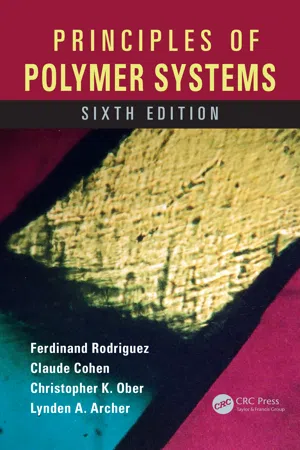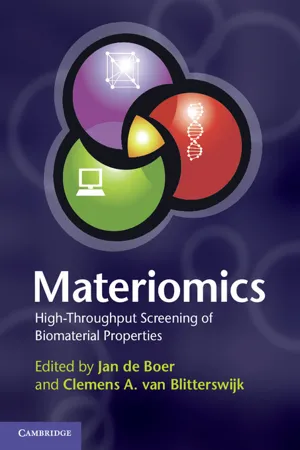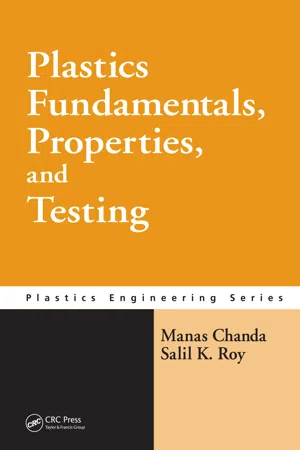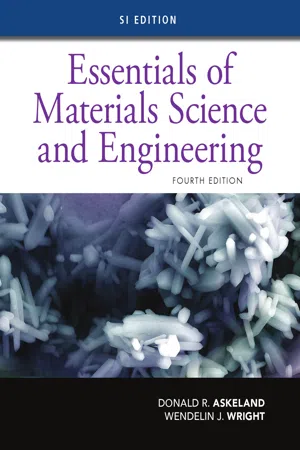Chemistry
Properties of Polymers
Polymers are large molecules made up of repeating units called monomers. They have unique properties, including high flexibility, low density, and resistance to chemicals and electricity. These properties make polymers useful in a wide range of applications, from packaging materials to medical devices.
Written by Perlego with AI-assistance
Related key terms
1 of 5
8 Key excerpts on "Properties of Polymers"
- eBook - PDF
- Robert O. Ebewele(Author)
- 2000(Publication Date)
- CRC Press(Publisher)
INTRODUCTION In Chapter 1, we observed that plastics have experienced a phenomenal growth since World War II, when they assumed enhanced commercial importance. This explosive growth in polymer applications derives from their competitive costs and versatile properties. Polymers vary from liquids and soft rubbers to hard and rigid solids. The unique Properties of Polymers coupled with their light weight make them preferable alternatives to metallic and ceramic materials in many applications. In the selection of a polymer for a specific end use, careful consideration must be given to its mechanical properties. This consideration is important not only in those applications where the mechanical properties play a primary role, but also in other applications where other characteristics of the polymer such as electrical, optical, or thermal properties are of crucial importance. In the latter cases, mechanical stability and durability of the polymer may be required for the part to perform its function satisfactorily. The mechanical behavior of a polymer is a function of its microstructure or morphology. Polymer morphology itself depends on many structural and environmental factors. Compared with those of metals and ceramics, polymer properties show a much stronger dependence on temperature and time. This strong time and temperature sensitivity of polymer properties is a consequence of the viscoelastic nature of polymers. This implies that polymers exhibit combined viscous and elastic behavior. For example, depend-ing on the temperature and stress levels, a polymer may show linear elastic behavior, yield phenomena, plastic deformation, or cold drawing. An amorphous polymer with T g below ambient temperature may display nonlinear but recoverable deformation or even exhibit viscous flow. - eBook - PDF
- Jozef Bicerano(Author)
- 2002(Publication Date)
- CRC Press(Publisher)
Two simple examples of the complementarity of certain Properties of Polymers are as follows: (a) Polymers with very low thermal expansion coefficients are desirable for applications in electronics. Such polymers are usually brittle. Brittleness is an undesirable attribute for a polymer, since a brittle specimen will break easily. (b) Polymers with very high heat distortion temperatures are desirable for applications requiring the retention of physical properties at very high use temperatures. Such polymers are usually very difficult to process in the melt Difficulty in melt processing is an undesirable attribute for a polymer. 2. The recognition of such interrelationships between properties has two benefits. Firstly, it can significantly reduce the number of independent variables which have to be consid- ered, and thus the amount of effort required, for the design and development of a new polymer or a new fabrication process. Secondly, it can provide a more realistic set of expectations concerning the maximum attainable performance and the tradeoffs which often have to be made between mutually conflicting “ideal” performance requirements. 3. The recognition of interrelationships between polymeric properties by using a systems approach can also guide fundamental research towards understanding the physical phenomena involved in the behavior of materials. 2 Prediction of Polymer Properties The properties of a polymer fall into two general classes: 1. Material properties are mainly related to the nature of the polymer itself. 2. Specimen properties are primarily consequences of the size, shape and layout of the finished specimens prepared from that polymer, and the process used to prepare these specimens. The separation of the Properties of Polymers into these two classes is unfortunately not always straightforward. Material properties affect the specimen properties, and fabri- cation conditions affect the observed material properties. - eBook - PDF
- Ferdinand Rodriguez, Claude Cohen, Christopher K. Ober, Lynden Archer(Authors)
- 2014(Publication Date)
- CRC Press(Publisher)
449 11 Some General Properties of Polymer Systems 11.1 DESIGN CRITERIA The final judgment on the suitability of a polymer for a given application usually involves a complex combination of properties. Some of these properties are inherent in the physical state of the polymer. A glassy material will not stretch, nor will an uncross-linked, amorphous polymer support a stress indefinitely when it is above its T g . Some properties are inherent in the chemical structure of the polymer. Hydrolysis, thermal dissociation, and toxicity may be fixed by the reactivity of certain groups within the polymer structure. In any application, cost is an important factor. The price of the polymer in the form of a powder, latex, solution, or bale is just part of the economic picture. The cost of other ingredients, equipment for fabrication, labor, power, and all the indirect costs, may well overshadow the polymer’s share. A first-line tire containing the best rubber sells for 10–20 times the cost of the raw rubber it contains. Even in a much less complicated structure, such as plasticized poly(vinyl chloride) laboratory tubing, the raw material cost may be less than one-tenth of the selling price. Some properties that might be considered for a single application are as follows: Appearance Density Mechanical properties Durability Thermal properties Flammability Electrical properties Chemical resistance to acids, bases, solvents, and oils 11.2 COMPOUNDING The polymer characteristics we have discussed so far are useful guideposts in pre-dicting the behavior of polymers in real applications. However, a lacquer is not an infinitely dilute solution, nor is a tire composed of ideal rubber. In many useful systems, the polymer is one of several constituents, and perhaps not the most impor-tant one. 450 Principles of Polymer Systems The largest volume synthetic rubber today, styrene–butadiene rubber (SBR), is a prime example of the complexities of polymer compounding for real life. - eBook - PDF
Materiomics
High-Throughput Screening of Biomaterial Properties
- Jan de Boer, Clemens A. van Blitterswijk(Authors)
- 2013(Publication Date)
- Cambridge University Press(Publisher)
The properties at the chemical level depend on the structural units, namely, what type of monomer comprises the chain and whether one or more than one type of monomer (copolymer) is used. * Physical properties are different for each material or combination of materials and relate primarily to properties at the chemical level (molecular structure, functional groups and degradability). * The interaction of cells with materials depends on physical properties such as hard- ness, topography and hydrophilicity because these properties allow or prevent the adhesion of biological compounds which are required to allow cell-spreading, migra- tion, proliferation and differentiation. * To overcome the difficulties related to exponentially growing numbers of materials, high-throughput methods were developed. * Automated pipettes, printers and analysis techniques facilitate the high-throughput characterization of large material libraries. * The development of new biomaterials using high-throughput techniques involves both the correlation of physico-chemical properties with cell–material interactions and finding (unexpected) hits where a material induces a desired response. * The production of material libraries using novel polymerization routes as shown in Section 2.3 will become very important. * The rapid development of data handling systems and effective informatics will become essential to handle fast-growing datasets. 26 E. Zant, M. J. Bosman and D. W. Grijpma Further reading Hook AL, Thissen H, Voelcker NH. Surface plasmon resonance imaging of polymer microarrays to study protein–polymer interactions in high throughput. Langmuir. 2009;25(16):9173–81. Parekh SH, Chatterjee K, Lin-Gibson S et al. Modulus-driven differentiation of marrow stromal cells in 3D scaffolds that is independent of myosin-based cytoskeletal tension. - eBook - PDF
- Ahmet Gurses(Author)
- 2015(Publication Date)
- Jenny Stanford Publishing(Publisher)
Therefore, anionic polymerization is perfectly suitable for manufacturing parts directly from the monomer via casting, reaction injection molding (RIM), and rotational molding (Rijswijk, 2007; Tung, 1993). 1.3 Properties of Polymers 1.3.1 Mechanical Properties Polymers are macromolecules that vary from liquids and soft rubbers to hard and rigid solids (Meijer and Govaert, 2005). The unique Properties of Polymers coupled with their light weight make them preferable alternatives to metallic and ceramic materials in many applications. In the selection of a polymer for a specific use, its mechanical properties must be taken into account. The term “mechanical properties” is commonly used to denote stress–strain relationships for polymer systems. Unlike many more familiar materials where these relationships depend essentially only on temperature, in polymeric systems time dependence is also important (Aklonis, 1981). This is important, not only in those applications where the mechanical properties play a primary role, but also in other applications where other characteristics of the polymer, such as electrical, optical, or thermal properties, are crucial. In the latter cases, mechanical stability and durability of the polymer may be required for the part to perform its function satisfactorily. Properties of Polymers 60 Polymers and Polymer Synthesis The mechanical behavior of a polymer is a function of its microstructure or morphology. Polymer morphology itself depends on many structural and environmental factors. Compared with those of metals and ceramics, polymer properties show a much stronger dependence on temperature and time. This strong time and temperature sensitivity of polymer properties is a consequence of the viscoelastic nature of polymers. This implies that polymers exhibit a combined viscous and elastic behavior. - eBook - PDF
- Saeed Farrokhpay(Author)
- 2023(Publication Date)
- Arcler Press(Publisher)
FUNDAMENTALS OF POLYMERIC MATERIALS 4 CONTENTS 4.1. Introduction ...................................................................................... 88 4.2. The History of the Concept of the Macromolecule ............................ 89 4.3. Classification of Polymers ................................................................. 91 4.4. Structure and Properties of Polymers ................................................. 93 4.5. Thermoplastic Polymers .................................................................... 93 4.6. Thermosetting Polymers .................................................................. 101 4.7. Naturally Occurring Polymers......................................................... 108 References ............................................................................................. 113 CHAPTER The Fundamentals of Materials Chemistry 88 4.1. INTRODUCTION A polymer is a big molecule comprised of a lot of smaller ones. Complex molecules can be strongly linked, mildly branching, or straight. The structure in the first example becomes a vast three-dimensional (3D) network (Morgan and Gilman, 2013; Dhote et al., 2019). Monomers are tiny molecules that serve as the fundamental foundations of larger compounds. The economically important substance poly(vinyl chloride), for example, is made from the monomer vinyl chloride. The polymer’s duplication component is usually the same as the monomer wherein the polymer was made. Although, there are several exceptions. Vinyl alcohol (CH 2 CHOH) recurring units are correctly considered to make up Poly(vinyl alcohol), yet there is no such monomer like vinyl alcohol. The relevant molecular unit is found in the alternate tautomeric for methanal (CH 3 CHO). The polymer poly(vinyl ethanoate) must first be made from the monomer vinyl ethanoate, and afterwards, the result must be hydrolyzed to create the polymer ethanol (Bloembergen, 1996; Roth and Baglay, 2016). - Manas Chanda, Salil K. Roy(Authors)
- 2008(Publication Date)
- CRC Press(Publisher)
1 Characteristics of Polymers 1.1 What Is a Polymer? A molecule has a group of atoms which have strong bonds among themselves but relatively weak bonds to adjacent molecules. Examples of small molecules are water (H 2 O), methanol (CH 3 OH), car bon dioxide, and so on. Poly mers contain thousands to millions of atoms in a molecule which is large; they are also called macromolecules. Poly mers are prepared by joining a large number of small molecules called monomers. Poly mers can be thoug ht of as big buildings, and monomers as the bricks that go into them. Monomers are generally simple organic molecules containing a double bond or a minimum of two active functional groups. The presence of the double bond or active functional groups act as the driv ing force to add one monomer molecule upon the other repeatedly to make a poly mer molecule. This process of transformation of monomer molecules to a poly mer molecule is know n as polym erization. For example, ethylene, the prototy pe monomer molecule, is ver y reactive because it has a double bond. Under the influence of heat, lig ht, or chemical agents this bond becomes so activated that a chain reaction of self-addition of ethylene molecules is generated, resulting in the production of a hig h-molecular-weight material, almost identical in chemical composition to ethylene, known as polyethylene, the poly mer of ethylene (Figure 1.1). The difference in behavior between ordinary organic compounds and polymeric materials is due mainly to the large size and shape of polymer molecules. Common organic materials such as alcohol, ether, chloroform, sugar, and so on, consist of small molecules having molecular weights usually less than 1,000. The molecular weights of polymers, on the other hand, vary from 20,000 to hundreds of thousands. The name polymer is derived from the Greek poly for many and meros for parts. A polymer molecule consists of a repetition of the unit called a mer .- Donald Askeland, Wendelin Wright(Authors)
- 2018(Publication Date)
- Cengage Learning EMEA(Publisher)
Polymers also have many useful physical properties. Some polymers, such as acrylics like Plexiglas™ and Lucite™, are transparent and can be substituted for glasses. Although most polymers are electrical insulators, special polymers (such as the acetals) and polymer-based composites possess useful electrical conductivity. Teflon has a low coefficient of friction and is the coating for nonstick cookware. Polymers also resist corrosion and chemical attack. 16-1 Classification of Polymers Polymers are classified in several ways: by how the molecules are synthesized, by their molecular structure, or by their chemical family. One way to classify polymers is to state if the polymer is a linear polymer or a branched polymer (Figure 16-1). A linear polymer consists of spaghetti-like molecular chains. In a branched polymer, there are primary polymer chains and secondary offshoots of smaller chains that stem from these main chains. Note that even though we say “linear,” the chains are actually not in the form of Copyright 2019 Cengage Learning. All Rights Reserved. May not be copied, scanned, or duplicated, in whole or in part. Due to electronic rights, some third party content may be suppressed from the eBook and/or eChapter(s). Editorial review has deemed that any suppressed content does not materially affect the overall learning experience. Cengage Learning reserves the right to remove additional content at any time if subsequent rights restrictions require it. 573 16-1 Classification of Polymers Figure 16-1 Schematic showing linear and branched polymers. Note that branching can occur in any type of polymer (thermoplastics, thermosets, and elastomers). (a) Linear unbranched polymer: notice chains are not straight lines and not connected. Different polymer chains are shown using different shades designed to show clearly that each chain is not connected to another. (b) Linear branched poly-mer: chains are not connected; however, they have branches.
Index pages curate the most relevant extracts from our library of academic textbooks. They’ve been created using an in-house natural language model (NLM), each adding context and meaning to key research topics.







